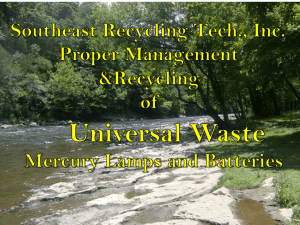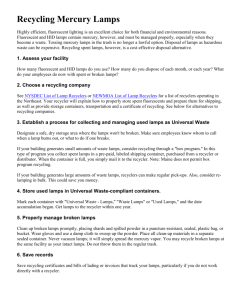Issue Table - Product Stewardship Institute
advertisement
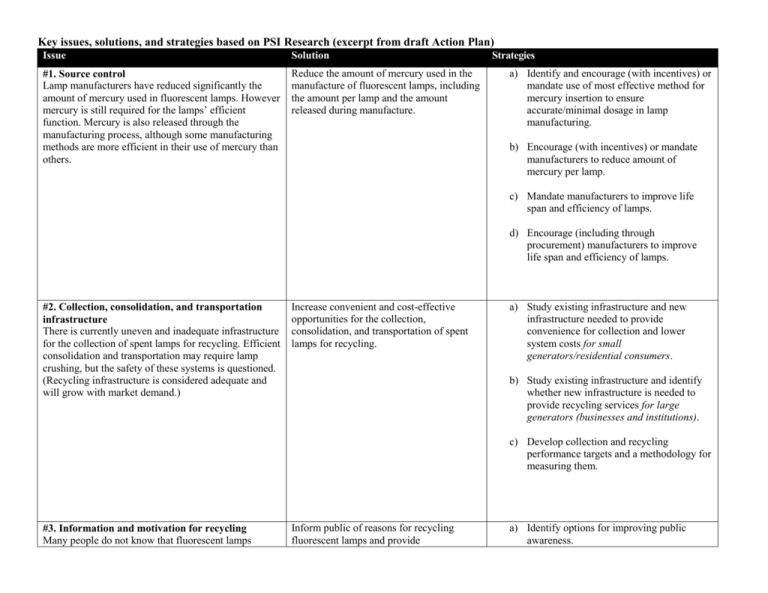
Key issues, solutions, and strategies based on PSI Research (excerpt from draft Action Plan) Issue Solution #1. Source control Lamp manufacturers have reduced significantly the amount of mercury used in fluorescent lamps. However mercury is still required for the lamps’ efficient function. Mercury is also released through the manufacturing process, although some manufacturing methods are more efficient in their use of mercury than others. Reduce the amount of mercury used in the manufacture of fluorescent lamps, including the amount per lamp and the amount released during manufacture. Strategies a) Identify and encourage (with incentives) or mandate use of most effective method for mercury insertion to ensure accurate/minimal dosage in lamp manufacturing. b) Encourage (with incentives) or mandate manufacturers to reduce amount of mercury per lamp. c) Mandate manufacturers to improve life span and efficiency of lamps. d) Encourage (including through procurement) manufacturers to improve life span and efficiency of lamps. #2. Collection, consolidation, and transportation infrastructure There is currently uneven and inadequate infrastructure for the collection of spent lamps for recycling. Efficient consolidation and transportation may require lamp crushing, but the safety of these systems is questioned. (Recycling infrastructure is considered adequate and will grow with market demand.) Increase convenient and cost-effective opportunities for the collection, consolidation, and transportation of spent lamps for recycling. a) Study existing infrastructure and new infrastructure needed to provide convenience for collection and lower system costs for small generators/residential consumers. b) Study existing infrastructure and identify whether new infrastructure is needed to provide recycling services for large generators (businesses and institutions). c) Develop collection and recycling performance targets and a methodology for measuring them. #3. Information and motivation for recycling Many people do not know that fluorescent lamps Inform public of reasons for recycling fluorescent lamps and provide a) Identify options for improving public awareness. Key issues, solutions, and strategies based on PSI Research (excerpt from draft Action Plan) Issue Solution contain mercury, or how/where to recycle them and why. Even in the case of large buildings/businesses that are required to recycle lamps, information and enforcement are inadequate. Lack of understanding of the environmental/health impacts, lack of regulation or enforcement, and lack of incentives to recycle decrease recycling of fluorescent lamps. incentives/disincentives to encourage recycling. #4. Sustainable financing A sustainable financing system is needed to conduct large-scale lamp recycling; current funding of pilot/small-scale projects is not sustainable, particularly in light of the anticipated future increase in the number of fluorescent lamps used. Develop a financing system that covers the collection, transportation, and recycling costs for fluorescent lamps now and in the future. Strategies b) Determine the role of incentives and/or disincentives required to increase recycling (including compliance/enforcement) for small generators/residential consumers. c) Determine the role of incentives and/or disincentives required to increase recycling (including compliance/enforcement) for large generators (businesses/institutions). To be identified by participants.
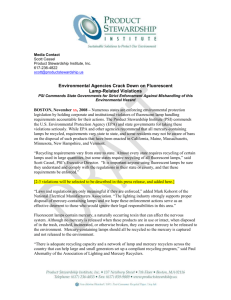

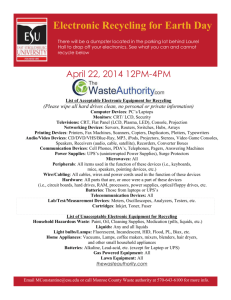



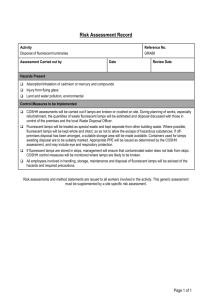

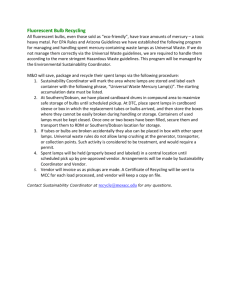
![School [recycling, compost, or waste reduction] case study](http://s3.studylib.net/store/data/005898792_1-08f8f34cac7a57869e865e0c3646f10a-300x300.png)
